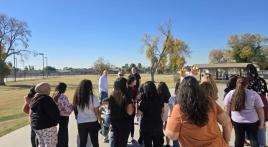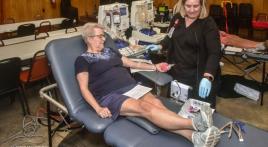I was taking my basic training at Lackland AFB for six weeks in January-February 1977. At that time, I was working as an editorial assistant for Washington Gas Light, and was 27. Since I had joined the West Virginia Air National Guard and had passed a bypass test for public affairs, I did not have to go to tech school after basic; but instead went directly to my ANG base in Martinsburg to fill out my three-month military obligation. In addition, my Washington Gas boss wanted me to do a story and take some photos when I returned from my training back to my gas company job.
My chartered bus passed through the gate of Lackland AFB near San Antonio, Texas, on Jan. 4, 1977. It was here at “Happy Valley,” as it was ironically called, that I would spend the next six weeks of my life in a most memorable way.
I was one of three Air National Guard trainees in the 010 Flight of the 3703 Squadron at Lackland AFB. The rest of my flight consisted of 46 regular trainees who were going to make the Air Force a career. In addition, there was one Air Force reservist trainee. Basic training consisted of physical conditioning, classroom instruction, marching and drilling, folding clothes in precise manners, work details, and learning to live with other men ranging in age from 18 to 27.
After our “buzz cuts,” we began to conform to Air Force standards. Training began each day at 5 am and ended precisely at 9 pm. After formation, we did aerobic warm-up exercises to prepare us for our mile and one half run. At the end of basic training, we were required to run this distance in 16 minutes (many of you fitness buffs might laugh at this. But I was not an athlete, only 5 feet 3 inches tall, and could not march to save my soul). This was not easy for me and I was always last in completing the runs. However, my fellow trainees were constantly giving me words of encouragement that somehow kept me going.
In the morning, we also had to make our beds, clean our personal areas and work in our assigned dormitory details. The dormitory details consisted of aligning shoes and beds, doing laundry, cleaning latrines, polishing metal, sweeping, and other duties designed to constantly keep our open-bay barracks in top order for inspection. During these inspections, we were graded on how we maintained our personal areas, and on uniform and shoe appearance.
After the first few weeks, we began our classroom instruction, which covered such areas as military law, customs and courtesies, sex education, drug and alcohol abuse, history, career advancement and personal development. There were two examinations on this material during the training.
The drill instructors seemed to pick on small guys like me and the overweight ones. Having been on my own in the working world for several years, I had a particular problem adjusting to this way of life-a life where you were told what to do, when to do it, and how to conduct yourself at all times. (I do not remember a whole lot of information from my Air Force classroom training during this period, but I do remember that I was made academic monitor and one of my duties was helping an African-American who had trouble with his sex education class. Since I was small, had a college degree and a job, I think my drill instructor had a special dislike for me and had enjoyment assigning me certain tasks.)
Other training included two days of M-16 rifle practice, one day of conquering an obstacle course, 14 straight hours of kitchen police (KP) and of course constant mental harassment by the training instructor (TI). These individuals, some of whom were women (yes, even then), were eager to intimidate trainees who they thought were not able to fit into the military system.
My Washington Gas boss mailed me a camera while I was in basic to take photo for my “boot camp” story. I put the camera in my footlocker to store. When my TI inspected my personal area, he discovered my camera and had a fit, turning over my bed, emptying out my footlocker. He then made me “Latrine Queen” during the San Antonio trip that all the others took near the end of the training. As it was, though I missed seeing the Alamo, that was fortunate for me; I was able to take photos of the obstacle course for my article
If you did not conform to the rules and pass the tests and inspections, you would be set back to redo training days, thus adding to the length of basic training. More than one time I was told that if I did not straighten up, I would be set back so far I would be “saluting civilians.” Actually, about 10 percent of each flight was usually set back for periods ranging from 1-2 weeks. I really do feel that the only reason I escaped that fate was that my TI did not want me to write about him in my Washington Gas newspaper. He did make it clear that when I left that if he saw his name in any article, my life would not be worth much.
Looking back on my basic training in 1977, I realized that despite my reservations about military life, the training showed me a lot about life. I was able to surpass limits that I had previously set for myself, and in the long run, my “boot camp” was a great sense of accomplishment.
Basic training
October 17, 2016
Submitted by:
Steven G. Swartz




